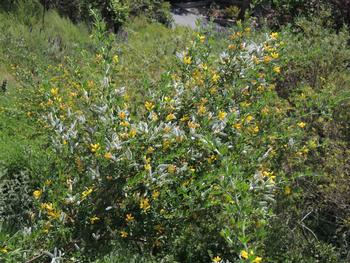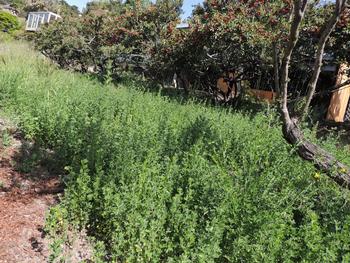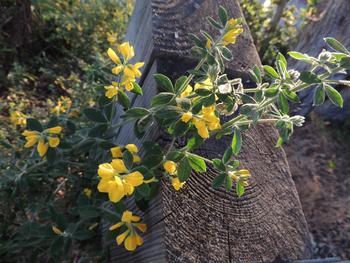Broom is not our garden friend
-
Diane Lynch
-
We're into late spring now, and the broom all around the county is into full reproduction mode, especially after the miracle rains last fall. If you're not familiar with broom, which is one of Marin's most invasive weeds, make a point to learn to recognize it. One of the most noxious weeds in the county, it has spread all over wildlands and our gardens. When small, it's very easy to pull, but it becomes entrenched and almost impossible to pull by hand as it gets larger. Fortunately, there are wrenches available to make the task easier. French broom (Genista monspessulana) is the most problematic in Marin, followed by Scotch broom (Cytisus scoparius).
 This young broom plant has dozens of maturing gray seed pods which will pop open and disperse the seed in the next few weeks. Photo: Diane Lynch
This young broom plant has dozens of maturing gray seed pods which will pop open and disperse the seed in the next few weeks. Photo: Diane LynchIn the pea family, French broom can grow to 12' and by fixing nitrogen into the soil, it gives an advantage to other invasives that require nitrogen. Many natives don't need much nitrogen… Shockingly, one mature broom plant can produce up to 20,000 seeds in a year. You can actually hear the hairy little pea pods pop open and spew the seeds.
Originally introduced from Europe as ornamental garden plants, brooms were later recommended by government agencies for erosion control along roadsides and in mined areas. This was the perfect storm for spread because broom loves disturbed soil, so it has colonized a lot of open space all over the state. On your way into San Francisco, glance up at the hills above Sausalito, and you'll see enormous swathes of its beautiful yellow flowers all over the open space. This small field was cleared a few months ago, disturbing the soil and allowing a large swathe of broom to grow. Photo: Diane Lynch
This small field was cleared a few months ago, disturbing the soil and allowing a large swathe of broom to grow. Photo: Diane LynchWhen you find broom in your garden, what should you do about it? There's been some controversy about digging or pulling the plants because seeds remain in the soil, and disturbed soil provides conditions for sprouting. However, Amanda Magallanes, Ring Mountain Stewardship Coordinator for Marin County, favors pulling broom, especially in home gardens. Pull small plants in the rainy season before the flowers set seed. The first year will be the most time-consuming, but the number of plants will rapidly decline in the first few years.
You can also cut large plants down to a stump, but you'll need to paint an herbicide on the fresh cut. This method is better than spraying to kill the entire plant, as overspray risks killing other nearby broad-leaf plants. You'll need to monitor the area to make sure the base doesn't sprout and remove any seedlings. Be sure to follow instructions carefully if you opt for an herbicide. However you choose to remove broom understand that it's a multi-year process since seeds can survive for 30 years, but in a few years, you'll have control and just be pulling an occasional sprout here and there.
Many retailers have stopped selling brooms, though I see purple cultivars in gardens and have seen purple broom (along with the ubiquitous yellow) on Mt. Tam in years past, so despite what the seller might say, it's best not to buy any broom. We have so many other plants available in our amazing part of the world that it's not hard to find something appropriate to plant. Plants from the other Mediterranean regions of the world do well here. Give consideration to natives since they evolved with local fauna and are the best-adapted plants for our climate. Broom is quite pretty but its aggressive nature crowds out natives and other more polite plants. Photo: Diane Lynch
Broom is quite pretty but its aggressive nature crowds out natives and other more polite plants. Photo: Diane LynchThere are heroic people all over Marin who are aware of broom's thuggish behavior and make efforts to remove it. For example, a group called Broom Busters has made a big dent in the French broom population in Old St. Hilary's Open Space Preserve in Tiburon over the past 20-plus years. They welcome volunteers of all ages to their workdays, generally the first Saturday of the month. For more information or to learn about broom removal workdays at Marin County Parks and Open Spaces, contact Greg Reza at greza@marincounty.org or check the calendar at https://www.parks.marincounty.org/discoverlearn/events-calendar.



